Leica Monopan 50 Review: Is It Just Re-Boxed Adox HR 50?
With the popularity of film photography reaching a fever pitch recently, seeing Leica announce its first-ever black and white 35mm film shouldn’t shock you. Leica is even making a film camera brand-new, so it makes a ton of sense. But is Leica Monopan 50 any good and — more importantly — is it unique?
Folks have been saying “film is back” for a while now, but it’s only been in the last year or so that it has really felt like that’s true. Last year, we got the first brand-new film camera in ages with the launch of the Pentax 17, and then, shockingly, we got a second one in the Rollei35AF. And who can forget about the Kodak Super 8 that finally came to market? Three film cameras in one year!
But that’s not all, we also got multiple brand-new film stocks in Harman Phoenix and Phoenix II, Red 125, and Kentmere Pan 200, while we are also seeing development of a new color film from Lucky and a new black and white stock from Light Lens Lab.
There hasn’t been this much buzz around film for decades, so it wasn’t super surprising to hear that Leica is launching its own black and white film: Monopan 50.
But is it really a brand-new film, or just a rebadge?
Leica Monopan 50 Review: Leica’s First Film, or Just Agfa?
Leica is calling this its first “true” black-and-white film. While the Leica I was the first-ever mass-produced 35mm film camera, and photographers of the era called the film loaded into it “Leica film,” the packs used with it were made by other manufacturers like Kodak, Agfa, and Perutz.
“Produced in Germany, Monopan 50 is particularly perfect for landscape, architectural, cityscape, and travel photography,” Leica says. “The film is compatible with all black-and-white developers. It guarantees complete control over black-and-white photography, ensuring the highest degree of detail.”
![]()
Given how Leica often puts its name on products originally manufactured by other brands – or at least based on cameras and lenses made by other companies – there is a healthy amount of skepticism that Leica actually manufactured its own film – especially one that is going to retail for just $10. Notwithstanding the difficulty of spinning up a brand-new film manufacturing facility, Leica isn’t historically known for making affordable products.
That’s why there are many folks who think that this film is just Adox 50, which wouldn’t necessarily be a bad thing since Adox is basically impossible to find in the US with any regularity, but Chris Niccolls has been led to believe that this is, in fact, a unique film emulsion. So what’s the truth?
When talking about film emulsions, things aren’t necessarily as straightforward as “this is just a repackage of ‘X’ film.” While it is possible that it is derived from a particular film, it might have been changed.
For example, the film we’re looking at today as a comparison is Adox 50, which is thought to be derived from Agfa Aviphot Pan 80, a film originally created for aerial photography. This film has been rumored to have spawned multiple other films. There is the Rollei RPX25 and Retro 80, the Adox 50, and many others. Which films are or are not based on this grandaddy Pan 80 film is a subject of debate among analog photographers and may or may not be true. What is important to take away from this is that while a film can be based on another film, changes to the film’s chemistry do result in different image renditions.

So let’s just say, for now, that it is possible that Leica Monopan 50 is just Adox 50. It is just as possible that Monopan 50 is simply based on the same original film emulsion as Adox 50, but with specific changes to the chemistry per Leica’s guidance. If the latter is true, then Leica did technically make a brand-new film. Even though it might share a lot in common with Adox, Rollei, or Agfa, it very well could be chemically different, and, hopefully, it may also produce photos that have their own unique appeal.
That’s not something I’m willing to say did or did not happen, since no one is going to be able to confirm or deny it. Leica certainly won’t. What we can do, instead, is take a look at both these films and decide if we can see a difference. In the end, that’s all that really matters, right?
To test this, I loaded two Nikon F cameras with each film: one with Monopan 50 and one with Adox 50. I then captured the exact same scene with both cameras, one after the other, using the same lens and camera settings. Both Nikon F cameras have recently been refubished and their shutters re-timed by KEH, so any variance between the two will be incredibly minor. The first photo will be with my Nikon Ftn so I can get a light meter reading and then I’ll transfer those same settings over to my base Nikon F. I am going to shoot this entire series with my Nikkor 50mm f/1.4 simply because it’s the fastest lens I own for this system, and this film is extremely slow. Even on a bright day, I’m going to need those extra stops of light.
I’ve never shot with any of the films that are supposedly spawned from Agfa, so this is an entirely new experience for me, too.
Leica Monopan 50 Review: Film Science
Even if Adox 50 and Monopan 50 are from the same base film, how could they still be different? Actually, how can Agfa Aviphot Pan 80 become a 25 speed film with Rollei and a 50 speed film with Adox? Now I’m a photographer, not a film scientist, so I don’t have this knowledge personally. However, I spoke with a former Ilford employee by the name of Graham Evelin, who is a fount of knowledge on how film development works.
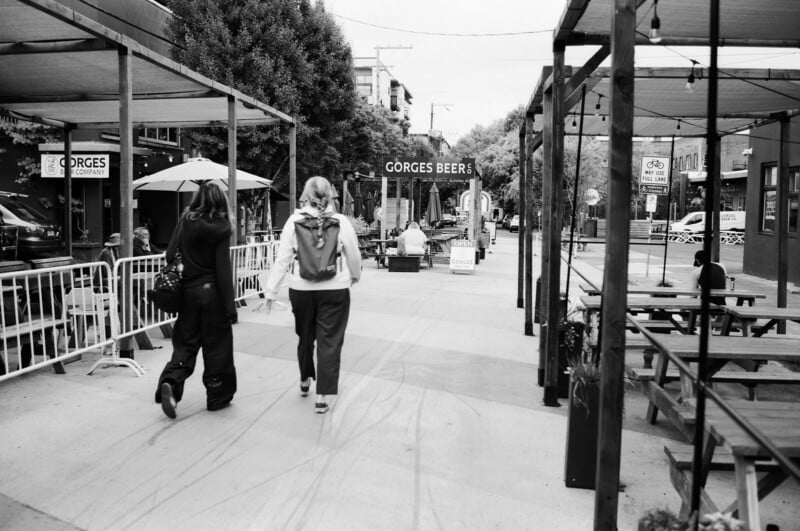
Film development often includes different-sized silver halide crystals; the bigger the area, the faster the film, so a lot of adjustments can be made to provide a specific speed of film. The actual coating thickness can be changed again to provide more or less performance for a given crystal density. Contrast can be altered along with tone range, sharpness, and exposure latitude, as well as its speed, so you have a wide range of things you can tweak based on what you are trying to achieve.
Since Graham worked for Ilford, he provided this example:
“Ilford`s Pan film is 50 ISO. Ilford B&W films are 125, 40, and 50 ISO, but could be tweaked if they decided to increase the speed. FP4 is a general-purpose emulsion that has great latitude, but Pan will reproduce tonal range better,” he says.
“For film coating, several layers may be involved that may be coated in one go or several, as B&W films are not single layer usually.”
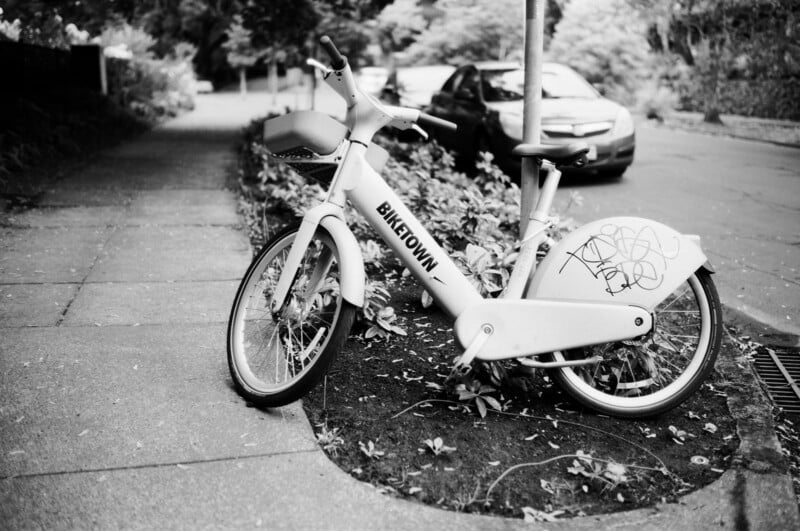
Coating requires specialized machinery, and many of the companies that would have been able to do it in film’s heyday either stopped or the companies ceased to exist. Other than companies like Harman, which added brand-new machinery in the last couple of years so that it could expand its film development, most remaining factories are using older equipment that has been maintained and adjusted over the years.
“All Silver Halide Crystals are only blue and UV light sensitive. Dye sensitisers are added to give you Ortho (Blue/Green), Pan (all visible), or IR sensitivity silver halide crystals,” Evelin continues.
“All B&W films tend to be a single-layer coating, but a few have an additional top protection coating where the emulsion is frail and not robust. Silver Halide crystals can be formed using Silver Bromide or a few other salts and can also provide different final film characteristics.”
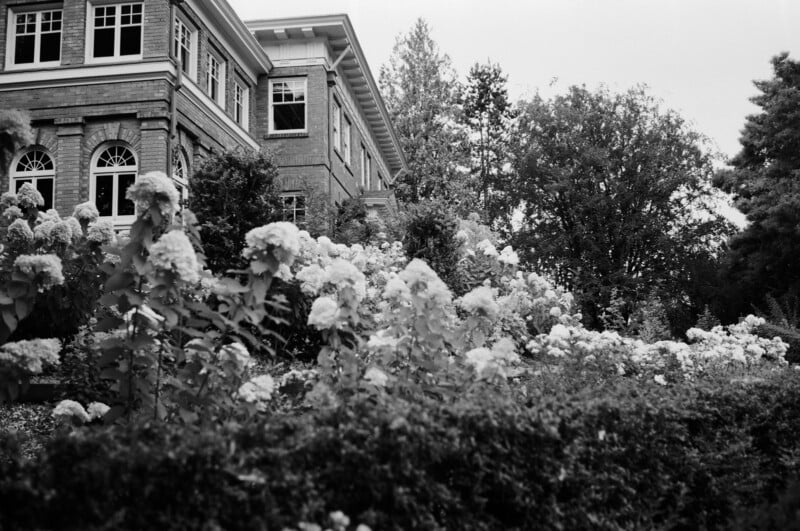
With all that in mind, you can see how one base film can become many other films that are, technically and visibly, different. So that’s why when Chris told me he was led to believe Adox 50 and Leica Monopan 50 are not the same, I can believe him.
But still, what is most important is whether we can see a difference. It doesn’t matter if they’re technically different if they produce the same photo, at least from a practical standpoint.
Leica Monopan 50 Review: Comparing Adox 50 and Leica Monopan 50
As expected, the negatives (and then scans) show us a lot. I was able to get a bunch of solid comparisons out of that roll in various lighting conditions and with different dominant colors. We can now take a look at how each of these film stocks handles exposure and color and make a real determination: is there a difference?
To recap, these photos were all taken with the same lens and the same settings on two Nikon F cameras within a few seconds of each other. Lighting was very consistent since it was a cloudless day, so any exposure differences we see are purely how the film reacted to the scene.
Below are two samples from the first series of images I took in the park: one of a swing set and one of a tree. You can immediately see there is a difference between these photos, and it is mainly in how the film stocks treat highlights.
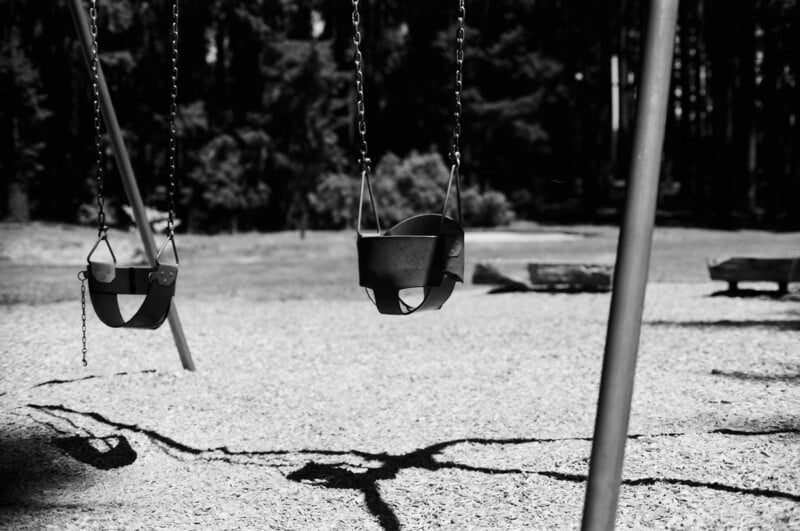
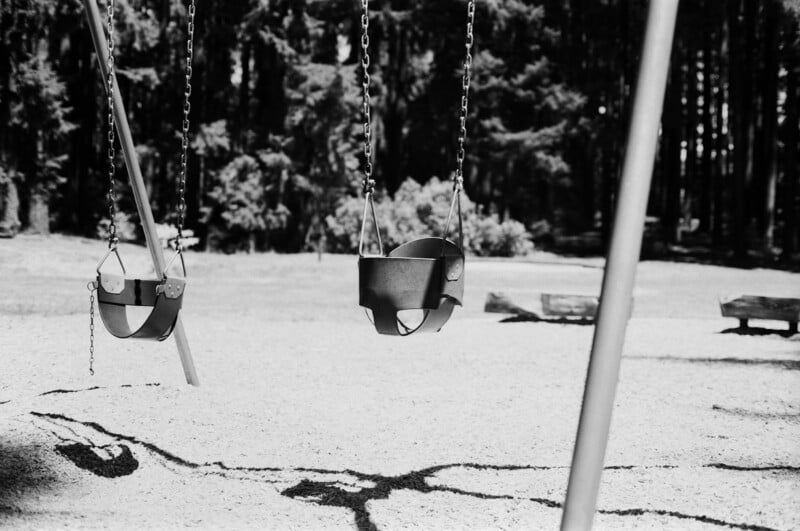
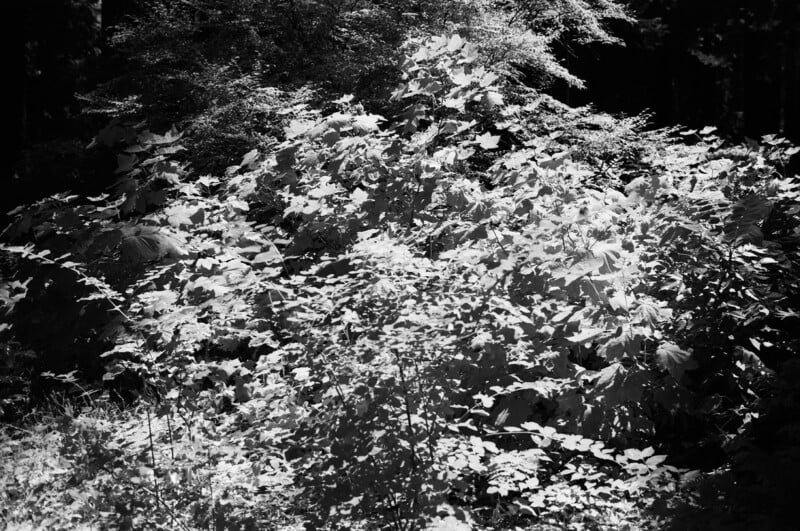
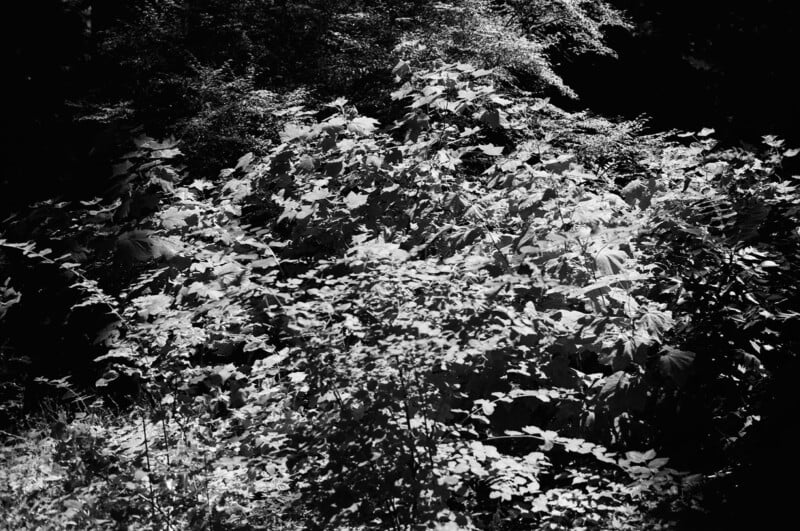
When I saw the sample images Leica provided when it announced Monopan 50, I had some concerns that it was blowing highlights. Looking at these photos, I can see that it wasn’t just necessarily the choice of the photographer: Monopan 50 loses highlight detail notably sooner than Adox 50 does. Highlights inch toward blown pretty quickly, for reasons that will be clearer after looking at the next pair of samples.
Looking at the photo of the scooters and the diner, we can see that Leica simply has a higher white point than Adox, and it likes to get there quickly; you can see that in the sky above the diner most clearly.
Zooming in on one of the scooters, you can also see that the Leica Monopan 50 film has more discernible grain. It’s not substantial, but it’s noticeable if you’re looking for it.
This next photo, which is of a vine growing next to a building, shows us some more interesting information: Leica Monopan 50 has a slightly different spectral response range. Greens just render differently, because knowing that my settings were the same between these two photos, there is more going on than what would be happening at first glance, which looks like an exposure difference. The lighting did not change between these images, so it’s clearly something happening with how the films see green.


The next pair confirms that and also shows the higher white points I mentioned before. Looking at the sky above the building, the Adox renders it in an off-gray, while the Leica film sends it closer to white.


These next two pairs of photos show more of what we now already know. Leica’s film pushes the greens to look brighter (look above the “Gateway to Nature” sign in the trees) and the white point is higher (look at the sky above the Blue Moon sign). You can also see that the Leica film is getting a bit more detail out of the shadows below the awning in the second set of photos.
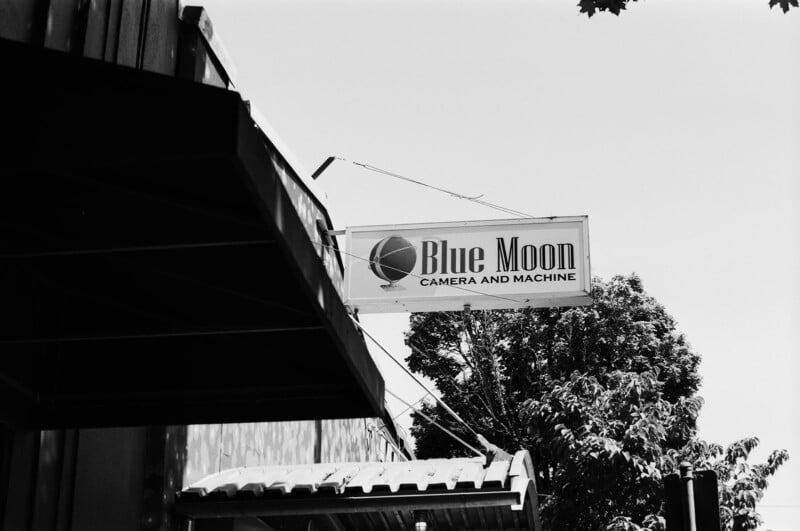



But there is something else to notice here: these films can also create nearly identical results depending on the subject. The rendering of the Gateway to Nature sign itself is nearly identical between the two photos.
In this next pair of photos, the one of painted wooden butterflies embedded in a chain link fence is fascinating to me because the only difference I can see between them is the grain profile. The exposure and tones of this image look exactly the same, which is notable because there isn’t any green in it at all.

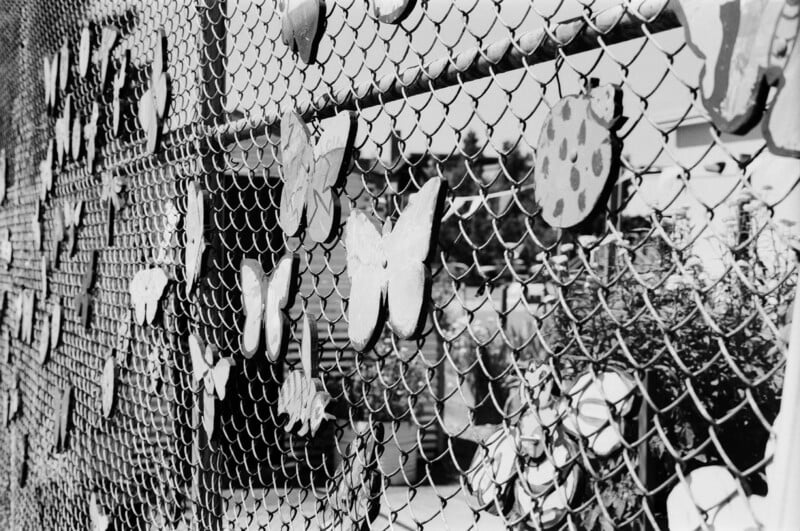
Finally, this photo of the edge of an umbrella set against a tree reinforces what we’ve been seeing to this point: Leica Monopan 50 gives us comparably more shadow detail and brighter greens, but bright areas go to nearly overexposed, while the Adox retains more detail there.


To me, it’s pretty obvious that what Chris was led to believe is in fact true: these are different films. They share a lot in common, but they have been coated differently and give us different, unique results.
However, I do think these are not only made in the same factory; I am fairly certain they are both based on Agfa Aviphot Pan 80. In addition to the evidence I’ve already outlined, I had another experience that sticks out.
My friend David Imel sent me one of his Fujifilm TX-1 cameras to use for a while, as I am considering getting one and wanted to try it out first. I thought that, in addition to the side-by-side samples, it would be neat to use my second roll of Leica Monopan 50 to shoot some panoramic shots with the TX-1. Unfortunately, I couldn’t.
You see, there is a known issue with loading Agfa film into the TX-1: it won’t recognize that there is any film in the camera and won’t activate the loading motor. It turns out that Agfa film is too thin, and the TX-1 doesn’t realize any film has been loaded.
When I put the Leica Monopan 50 film into the TX-1, nothing happened. That’s too many coincidences.



I did end up shooting that roll on my Bessa R2a, so I did get more samples using a rangefinder, which I think is apt for Leica-branded film.
Leica Monopan 50 is Unique, if Only Just
When we were looking at this film, we decided to take one of the shots and equalize the perceived exposure (bring the skies in line) and found that on a histogram, we do see a difference. Adox has a slightly slower movement toward overexposure, but both film stocks come in from pure black at almost the same point.
![]()
As an aside, it’s kind of funny how quickly the histogram goes from “info, info, info” to “no info” with both these films. They have very tight windows where there is detail before it gets lost entirely to black or white. The result is some really stark contrast, which I like a lot.
However, there is clearly a difference. That gives us a definitive answer: no, Adox 50 is not the same as Leica Monopan 50.

Leica Monopan 50 is a sharp, contrasty film with stark, sudden breaks to a high white point. When Leica says this is a great film for architecture and cityscapes, I can see why: cities will render gorgeously sharp and stand out cleanly from skies that will lean to pure white. For artistic black and white photos of buildings, that looks really good.
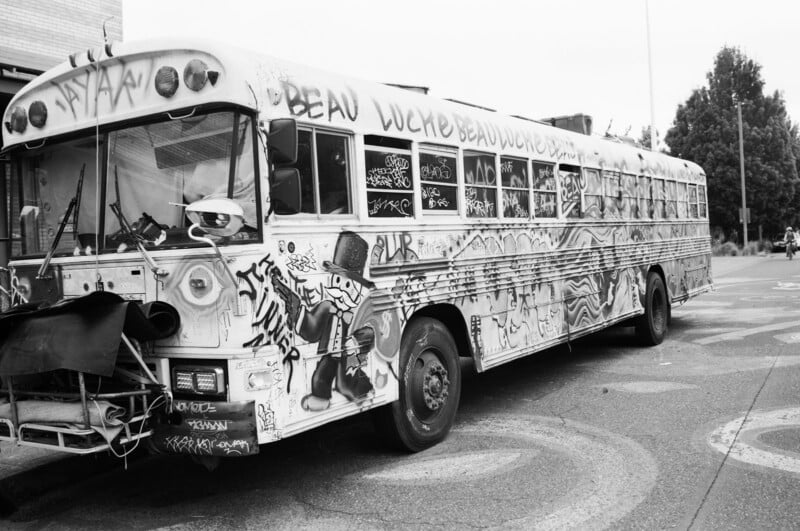
You can certainly work these negatives in a darkroom to enhance these characteristics onto a print. You just have to go into this knowing that at a certain contrast point, there will be no detail to pull from either in the shadows or the highlights.
It’s a rather unforgiving film that can be hard to work with. I think if you like this look, Adox will give you a bit more dynamic range and wiggle room, and it is certainly possible to push Adox 50 negatives to the same high-key look Leica Monopan 50 gives you. The only thing that isn’t replicable between the two is Monopan 50’s grain structure, which I think is slightly more noticeable than on Adox 50. That is going to come down to individual preferences.
![]()
One thing to note is that I have heard Leica only plans to sell Monopan 50 through official Leica retailers, which is disappointing and limiting. Many of the small shops where film thrives aren’t officially recognized by Leica, and therefore might not be given the opportunity to sell this film. Blue Moon Camera and Machine here in Portland, for example, doesn’t expect to be able to get any.

And that’s especially unfortunate since they don’t get any Agfa films in right now, including Adox 50. One of the reasons I didn’t care if these films were the same (which they aren’t) was that I assumed Leica would make it more easily obtainable for folks like me out here, where Adox just doesn’t show up often or at all. That is going to be less of a thing than I had hoped, by the sounds of it.
Are There Alternatives?
If you can’t get your hands on Leica Monopan 50, luckily, there are alternatives. Rollei Ortho 25 Plus, RPX 25, and RPX 100 are rumored to be based on the same grandaddy Agfa film and render similar profiles. Of course, there is also Agfa 50, which comes very close to Leica Monopan 50, but doesn’t quite reach the same high white point. You can, however, always fix that in the darkroom or in post-production.
Should You Buy It?
Yes. Leica Monopan 50 is an affordable, sharp, black and white film that renders a very lovely negative. It’s tough to use and is very slow, but as long as you know how it reacts to certain scenes (and especially greens), you can get some beautiful results.